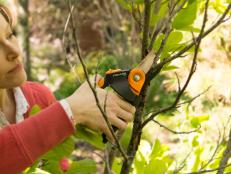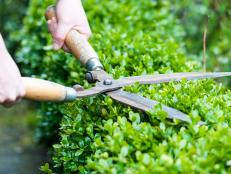Tree Removal: You May Want to Consider an Expert

The lumps and bumps in the yard aren't clumps of dirt; they're the roots of your favorite crape myrtle making their way to the driveway.
You can try having a protective barrier put in the ground between the roots and driveway, but if that doesn't work, you may have to take out the tree.
"Most often, people want to remove a tree because it's planted in the wrong location," says Brock Lindsey, general manager of a tree service and arborist in Fresno, Calif. "It grows too big and becomes a problem with the driveway and sidewalk." Other times, the tree is diseased, dead or cracked, making it a nuisance and hazard.
The best way to take out a tree is to not leave it to amateurs. You might think you can handle a tree-removal job on your own with a chain saw and ladder, but there's more to it than that.
"People will go up, get up on a ladder with a chain saw, which is really dangerous, and they don't estimate how much debris (the job) generates," Lindsey says.
"They almost never predict how difficult it is to remove a stump. You'll see trunks of trees where people just left them."
Joe Villagomez, owner of Joe's Tree Service in Fresno, says that people often don't know how to cut a tree properly. He says a ladder isn't always the best tool.
"It's very dangerous," Villagomez says. "Limbs hit the ladder, and there you go — you're off."
The type of tree also makes a difference in terms of how it bends and how much weight it can handle, says Curt Blank, an arborist and horticulturist with A-1 Expert Tree Service in Fresno.
Even when the tree is short or a dwarf, think before you tackle it yourself.
"Something up to 15 feet, an average person can handle, but there's so many unpredictables — such as how the tree twists and spins when cut," Lindsey says.
If the tree you need to remove is less than 15 feet tall, generally, landscape maintenance companies can take care of it, he says. For anything taller, consider a licensed tree-removal company.
One tree to stay away from is the palm tree, which has heavy fronds that can injure you if improperly removed.
"They're terribly dangerous," Lindsey says. The fronds "can weigh a ton. They're poorly attached. They can slide down on you and crush you. Leave that to the experts."
Typically, tree-removal companies take care of the tree in three steps: They take it down, they remove and dispose of the limbs, and they grind the stump into tiny chips. You can have the company do some or all of the steps.
When companies cut down the tree, they may use a crane, chain saws and rope, to make sure it doesn't fall on a house or garage.
Villagomez and Lindsey are reluctant to say how much a tree-removal job usually costs, saying it depends on a number of factors, including which tools they need to how far they will have to travel between their work truck and the tree.
"The same tree in the front yard will be cheaper than the back yard," Lindsey says.
Cutting down a tree is often the last choice tree-removal businesses like to make. If they can, they'll try to save it by talking to the homeowner to see what options are available.
The easiest way not to see a tree removed is to plant one suitable for the location in the first place.
"Be sure to research the full size of the tree, and plant it in the right location," Lindsey says.
His suggestion: "Plant deciduous trees on the south and west sides of a house.
"You get shade in the summer and sunlight during the winter."
(Nzong Xiong writes for the Fresno Bee.)













































